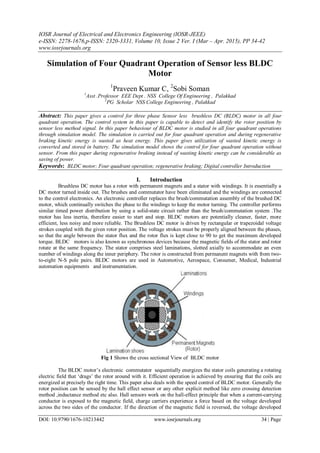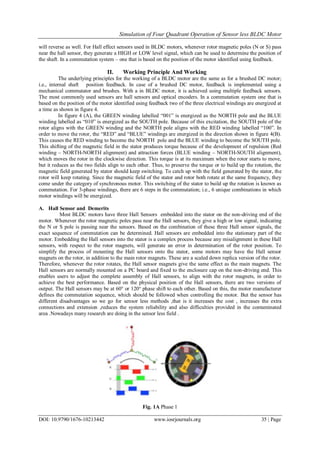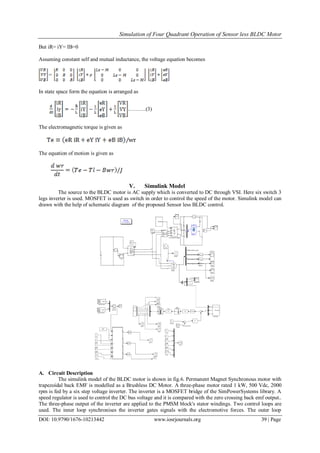This document summarizes a simulation of four quadrant operation of a sensorless brushless DC motor. It begins with an introduction to brushless DC motors and their operation. It then discusses sensorless control methods, specifically zero crossing detection. The paper presents the mathematical model and Simulink model for simulating four quadrant motor operation including regenerative braking. During regenerative braking, kinetic energy is converted and stored in a battery rather than wasted as heat. The simulation demonstrates control of the motor across four quadrants without position sensors.








![Simulation of Four Quadrant Operation of Sensor less BLDC Motor
DOI: 10.9790/1676-10213442 www.iosrjournals.org 42 | Page
also the effectiveness of the sensor less. The time taken to achieve this braking is comparatively less. The
generated voltage during the regenerative mode can be returned back to the supply mains which will result in
considerable saving of power. This concept may well be utilized in the rotation of spindles, embroidery
machines and electric vehicles where there is frequent reversal of direction of rotation of the motor .In the
contaminated situation this proposal more effective The significant advantages of the proposed work are: simple
hardware circuit, reliability of the control algorithm, excellent speed control, smooth transition between the
quadrants and efficient conservation of energy is achieved with and without
load conditions .Simulation result shows DC output and battery energization when the motor is in braking
condition.
About The Authors
Mr Praveen Kumar C is working as Assistant Professor in the Department of Electrical and Electronics
Engineering at NSS College of Engineering, Palakkad, Kerala. He received the ME Degree in Mechatronics
from Anna University in 2013. His areas of interest include Special Machines, Linear Machines and Jet
propulsion.
Ms Sobi Soman is pursuing her M Tech degree in Power Electronics at NSS College of Engineering,
Palakkad. She is doing her Master Research Project in the area of Brushless DC Motor .
References
[1]. C. S. Joice, Dr. S. R. Paranjothi, and Dr. V. J. S. Kumar, ―Practical implementation of four quadrant operation of three phase
Brushless DC motor using dsPIC,‖ in Proc. IConRAEeCE 2011, 2011, pp. 91.97, IEEE.
[2]. P. Yedamale, Microchip Technology Inc., ―Brushless DC (BLDC) motor fundamentals,‖ 2003, AN885.
[3]. B. Singh and S. Singh ―State of the art on permanent magnet brushless DC motor drives,‖ J. Power Electron., vol. 9, no. 1, pp. 1–
17, Jan,09.
[4]. L. N. Elevich, ―3-phase BLDC motor control with hall sensors using 56800/E digital signal controllers,‖ AN1916, Application
Note, Rev. 2.0, 11/2005.
[5]. Afjei, O. Hashemipour, M. A. Saati, and M. M. Nezamabadi, ―A new hybrid brushless DC motor/generator without permanent
magnet,‖ IJE Trans. B: Appl., vol. 20, no. 1, pp. 77–86, Apr. 2007.
[6]. C. Xia, Z. Li, and T. Shi, ―A control strategy for four-switch three brushless DC motor using single current sensor,‖ IEEE Trans.
Ind. Electron., vol. 56, no. 6, pp. 2058–2066, June 2009.
[7]. C.-W. Hung, C.-T. Lin, C.-W. Liu, and J.-Y. Yen, ―A variable sampling controller for brushless DC motor drives with low-
resolution position sensors,‖ IEEE Trans. Ind. Electron., vol. 54, no. 5,pp 2846–2852, Oct. 2007.
[8]. R. Krishnan, S.-Y. Park, and K. Ha, ―Theory and operation of a four quadrant switched reluctance motor drive with a single
controllable switch—the lowest cost four-quadrant brushless motor drive,‖ IEEE Trans. Ind. Appl., vol. 41, no. 4, pp. 1047–1055,
2005.
[9]. A. Sathyan,M. Krishnamurthy, N.Milivojevic, and A. Emadi, ―A Low cost digital control scheme for brushless DC motor drives in
domestic applications,‖ in Proc. Int. Electric Machines Drives Conf., 2009,pp 76–82.
[10]. W. Cui, H. Zhang, Y.-L. Ma, and Y.-J. Zhang, ―Regenerative braking control method and optimal scheme for electric motorcycle,‖
in Proc. Int. Conf. Power Engineering, Energy and Electrical Drives, Spain, 2011, pp. 1–6.
[11]. M. K. Yoong, Y. H. Gan, G. D. Gan, C. K. Leong, Z. Y. Phuan, B. K. Cheah, and K. W. Chew, ―Studies of regenerative braking in
electric vehicle,‖ in Proc. IEEE Conf. Sustainable Utilization Development Eng. Technol., Malaysia, Nov. 2010, pp. 40–45.
[12]. M.-F. Tsai, T. PhuQuy, B.-F. Wu, and C.-S. Tseng, ―Model construction and verification of a BLDC moto r using
MATLAB/SIMULINK and FPGA control,‖ in Proc. 6th IEEE Conf. Ind Electron. Appl., Beijing, 2011, pp. 1797–1802.](https://image.slidesharecdn.com/e010213442-160705055817/85/E010213442-9-320.jpg)